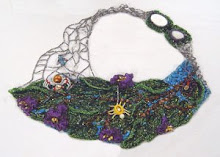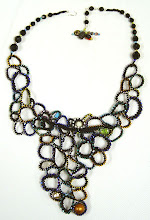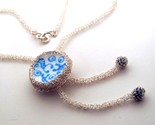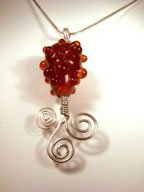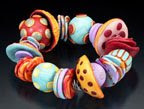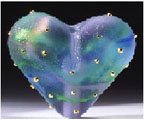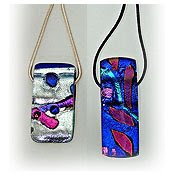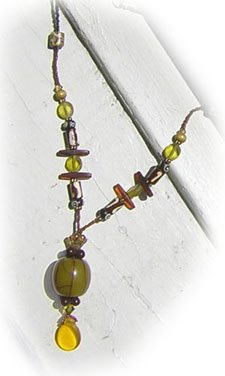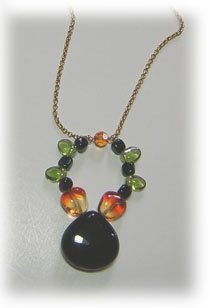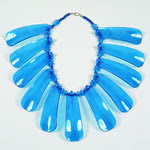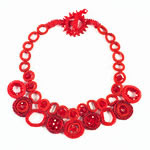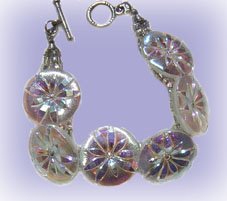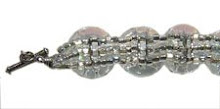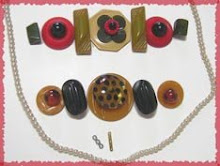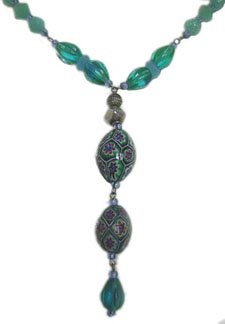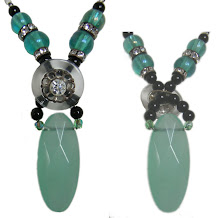The best deal in town for every New York City and tri-state area beaders/jewelry artisans is the Bead Society of Greater New York. For a very small sum of $5.00 one can go to a meeting and learn something new, meet other wonderful artists, exchange ideas and generally have a great time.
They have scheduled a three day retrospective at the Fashion Institute of Technology
JUNE MEETING: WORLD OF BEADS VIII:
A 20 Year Retrospective
JUNE 19-21, 2009 at Fashion Institute of Technology’s Great Hall
It sounds really like something not to be missed...I myself will be there. They are calling for volunteers, if you are interested.
May 28, 2009
May 27, 2009
The Lustrous Beauty of Czech Glass
When did I fall in love with Czech Glass buttons? Actually it was during my search for Bakelite Buttons about three or more years ago. I discovered these buttons in sets of six, which was the perfect number for a bracelet because of their size; three-quarters of an inch. I was knocked off my feet by their beauty, iridescence, variety of patterns and lustrous color. They were gorgeous!
I knew that the Czech Republic was known for their manufacturing of glass high-fire polish beads, but was unaware at the time of their button manufacturing. Through my research, I found that they had a large number of factories producing the buttons for over 100 years. While purchasing these buttons I learned from the vendors that most of the factories had closed once WWII began. I assumed that the buttons that they were selling were coming from the stock left abandoned once the factory was closed. I thought the availability of these buttons was limited. Just recently in doing research for this post, I happily found that there are one or two factories still in operation, and that the 100- year old molds and the techniques for making these buttons are being used today. In a sense, these are vintage buttons that are being created today.
Only the Czechs make them. The quality is superb and even if they are a bit pricey it is well worth having them to incorporate them into your bracelet and necklace designs.
I found that these buttons come from a specific area called North Bohemia and is known as the "Glass Capital of The World", with a glass-making history dating back as far as 1376.
To make the bracelets and necklaces with these buttons, I use the same techniques to create my Bakelite button bracelets (please check previous post ). I can incorporate the buttons into necklaces using the same technique, also, explained in the post titled “The Joy of Vintage”.
With these buttons, because they are uniform in size, you can use the simpler technique using the elastic called Stretch Magic made by Pepperell Braiding Company. I use the .7 mm size. It is lighter, but just as strong as the next size up…but I am sure that it will go through all holes. For the connecting beads, I use a flat bead. Please check the photos for a view of the bead.
I have, for your convenience, added some sources for these magnificent buttons:
http://www.smarter.com, www.everyonelovesbuttons.com, http://www.abeadstore.com, http://www.joggles.com, http://www3.quantissimo.com
I knew that the Czech Republic was known for their manufacturing of glass high-fire polish beads, but was unaware at the time of their button manufacturing. Through my research, I found that they had a large number of factories producing the buttons for over 100 years. While purchasing these buttons I learned from the vendors that most of the factories had closed once WWII began. I assumed that the buttons that they were selling were coming from the stock left abandoned once the factory was closed. I thought the availability of these buttons was limited. Just recently in doing research for this post, I happily found that there are one or two factories still in operation, and that the 100- year old molds and the techniques for making these buttons are being used today. In a sense, these are vintage buttons that are being created today.
Only the Czechs make them. The quality is superb and even if they are a bit pricey it is well worth having them to incorporate them into your bracelet and necklace designs.
I found that these buttons come from a specific area called North Bohemia and is known as the "Glass Capital of The World", with a glass-making history dating back as far as 1376.
To make the bracelets and necklaces with these buttons, I use the same techniques to create my Bakelite button bracelets (please check previous post ). I can incorporate the buttons into necklaces using the same technique, also, explained in the post titled “The Joy of Vintage”.
With these buttons, because they are uniform in size, you can use the simpler technique using the elastic called Stretch Magic made by Pepperell Braiding Company. I use the .7 mm size. It is lighter, but just as strong as the next size up…but I am sure that it will go through all holes. For the connecting beads, I use a flat bead. Please check the photos for a view of the bead.
I have, for your convenience, added some sources for these magnificent buttons:
http://www.smarter.com, www.everyonelovesbuttons.com, http://www.abeadstore.com, http://www.joggles.com, http://www3.quantissimo.com
May 15, 2009
Bakelite…The Amazing Plastic of the Early 20th Century
What is the lure of Bakelite today? Why do people spend hundreds of dollars for a carved bangle bracelet, a pin, a necklace made from this first plastic invented c.1909 by Belgian inventor, Chemist L.H.Baekeland? I would say it is the lure of Vintage…owning something from a bygone period--and above all, the artisanship of the pieces.
Bakelite is the most well known of the earlier plastics, though people tend to lump all the early plastics under the title of Bakelite. The value of Bakelite is almost always higher than the other plastics. However, these other plastics are just as wonderful as Bakelite and have their value too. Parkesine (1862), Xylonite (1869), Celluloid (1869), Galalith (1897, aka Erinoid and French Bakelite), Bakelite (1909), Catalin (1927), and Lucite (1931, aka Plexiglas or Perspex). The first two, Parkesine and Xylonite, failed, but Galalith is still used today; primarily for making buttons. Lea Stein and Pavone are two recognized modern designers of French Bakelite Jewelry.
I fell in love with these wonderful early plastics in the form of buttons. To me they each were small pieces of sculpture. The questions were first of all, how to find the buttons at reasonable prices, and then how to assemble the buttons in a design that was fetching, beautiful and comfortable. My answer came to me with much experimentation. After time and great effort I had my product. Because of the construction of the button, its center of gravity being in the center, I felt that bracelets would be the best form for their use. I tried stretch elastic which is great for some designs, but not all. I finally came across the best solution for all types of buttons. Using small beads, 3-hole spacers and wire, I was able to construct a stylish bracelet for the buttons. Because I like the look of graduated sizes, I was also able to use a greater variety of buttons for each bracelet.
Mind you, the rare Bakelite button, the intricately carved buttons are very expensive, so cost-wise it made no sense. I picked a moderately-priced button or group of buttons, and I also incorporated other early plastics into some of the bracelets. The overall look is absolutely appealing--and never misses the eye of the customer. They are all also one-of-a-kind which is another appealing element!
Please take a look at the photos to see some samples.
I would like to continue for my next posting, Vintage glass buttons from the Czechoslovakian factories. Please keep an eye out.
Bakelite is the most well known of the earlier plastics, though people tend to lump all the early plastics under the title of Bakelite. The value of Bakelite is almost always higher than the other plastics. However, these other plastics are just as wonderful as Bakelite and have their value too. Parkesine (1862), Xylonite (1869), Celluloid (1869), Galalith (1897, aka Erinoid and French Bakelite), Bakelite (1909), Catalin (1927), and Lucite (1931, aka Plexiglas or Perspex). The first two, Parkesine and Xylonite, failed, but Galalith is still used today; primarily for making buttons. Lea Stein and Pavone are two recognized modern designers of French Bakelite Jewelry.
I fell in love with these wonderful early plastics in the form of buttons. To me they each were small pieces of sculpture. The questions were first of all, how to find the buttons at reasonable prices, and then how to assemble the buttons in a design that was fetching, beautiful and comfortable. My answer came to me with much experimentation. After time and great effort I had my product. Because of the construction of the button, its center of gravity being in the center, I felt that bracelets would be the best form for their use. I tried stretch elastic which is great for some designs, but not all. I finally came across the best solution for all types of buttons. Using small beads, 3-hole spacers and wire, I was able to construct a stylish bracelet for the buttons. Because I like the look of graduated sizes, I was also able to use a greater variety of buttons for each bracelet.
Mind you, the rare Bakelite button, the intricately carved buttons are very expensive, so cost-wise it made no sense. I picked a moderately-priced button or group of buttons, and I also incorporated other early plastics into some of the bracelets. The overall look is absolutely appealing--and never misses the eye of the customer. They are all also one-of-a-kind which is another appealing element!
Please take a look at the photos to see some samples.
I would like to continue for my next posting, Vintage glass buttons from the Czechoslovakian factories. Please keep an eye out.
Labels:
bakelite,
bakelite buttons,
bracelets,
French Bakelite jewelry,
galalith,
Lea Stein,
parkesine,
Pavone,
sculpture,
vintage
Subscribe to:
Posts (Atom)

